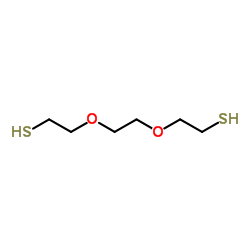2,2′-(1,2-乙二基双氧代)双乙硫醇

2,2′-(1,2-乙二基双氧代)双乙硫醇结构式

|
常用名 | 2,2′-(1,2-乙二基双氧代)双乙硫醇 | 英文名 | 3,6-DIOXA-1,8-OCTANEDITHIOL |
|---|---|---|---|---|
| CAS号 | 14970-87-7 | 分子量 | 182.304 | |
| 密度 | 1.1±0.1 g/cm3 | 沸点 | 257.0±30.0 °C at 760 mmHg | |
| 分子式 | C6H14O2S2 | 熔点 | N/A | |
| MSDS | 中文版 美版 | 闪点 | 109.2±24.6 °C | |
| 符号 |


GHS07, GHS09 |
信号词 | Warning |
|
The influence of linker length on the properties of cathepsin S cleavable177Lu-labeled HPMA copolymers for pancreatic cancer imaging
Biomaterials 35(22) , 5760-70, (2014) N-(2-hydroxypropyl)-methacrylamide (HPMA) copolymers have shown promise for application in the detection and staging of cancer. However, non-target accumulation, particularly in the liver and spleen, hinders the detection of resident or nearby metastatic lesi... |
|
|
Dual-targeted polyplexes based on sequence-defined peptide-PEG-oligoamino amides.
J. Pharm. Sci. 104(2) , 464-75, (2015) For active cell targeting, viruses frequently capitalize on dual-receptor binding. With the intention to mimic this natural process, a dual peptide-based approach for targeting cancer cells was evaluated. For this purpose, sequence-defined pDNA binding oligo ... |
|
|
Development and in vitro assessment of enzymatically-responsive poly(ethylene glycol) hydrogels for the delivery of therapeutic peptides.
Biomaterials 35(36) , 9719-30, (2014) Despite the recent expansion of peptide drugs, delivery remains a challenge due to poor localization and rapid clearance. Therefore, a hydrogel-based platform technology was developed to control and sustain peptide drug release via matrix metalloproteinase (M... |
|
|
Development of peptide-based lineage-specific serology for chronic Chagas disease: geographical and clinical distribution of epitope recognition.
PLoS Negl. Trop. Dis. 8(5) , e2892, (2014) Chagas disease, caused by infection with the protozoan Trypanosoma cruzi, remains a serious public health issue in Latin America. Genetically diverse, the species is sub-divided into six lineages, known as TcI-TcVI, which have disparate geographical and ecolo... |
|
|
The use of DODT as a non-malodorous scavenger in Fmoc-based peptide synthesis.
Protein Pept. Lett. 9(5) , 379-85, (2002) We have synthesized a random group of peptides and performed cleavages using various cleavage cocktails including 3,6-dioxa-1,8-octanedithiol (DODT). Purity of the peptides was compared to that obtained with standard protocols for cleavage using RP-HPLC and M... |
|
|
Functional mapping of the interaction between TDP-43 and hnRNP A2 in vivo.
Nucleic Acids Res. 12th ed., 37 , 4116-4126, (2009) Nuclear factor TDP-43 has been reported to play multiple roles in transcription, pre-mRNA splicing, mRNA stability and mRNA transport. From a structural point of view, TDP-43 is a member of the hnRNP protein family whose structure includes two RRM domains fla... |
|
|
Copper(II) and nickel(II) binding sites of peptide containing adjacent histidyl residues.
J. Inorg. Biochem. 151 , 87-93, (2015) Copper(II) and nickel(II) complexes of the terminally protected nonapeptide Ac-SGAEGHHQK-NH2 modeling the metal binding sites of the (8-16) domain of amyloid-β have been studied by potentiometric, UV-vis, CD and ESR spectroscopic methods. The studies on the m... |
|
|
Temporally tunable, enzymatically responsive delivery of proangiogenic peptides from poly(ethylene glycol) hydrogels.
Adv. Healthc. Mater. 4 , 2002-11, (2015) Proangiogenic drugs hold great potential to promote reperfusion of ischemic tissues and in tissue engineering applications, but efficacy is limited by poor targeting and short half-lives. Methods to control release duration or provide enzymatically responsive... |
|
|
Secondary Structural Preferences of Some Antibacterial Cyclooctapeptides in the Presence of Calcium(II).
Int J Med Chem 2012 , 730239, (2014) The purpose of this study is to understand the interactions of some antibacterial cationic amphipathic cyclooctapeptides with calcium(II) and their secondary structural preferences. The thermodynamic parameters associated with calcium(II) interactions, betwee... |